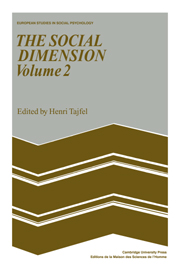Book contents
- Frontmatter
- Contents
- Contributors
- PART IV Representations of social reality
- PART V Group processes
- 23 Social groups, nonsense groups and group polarization
- 24 The influence of minorities: ten years later
- 25 Social identification and psychological group formation
- PART VI Intergroup relations
- Subject index
- Author index
23 - Social groups, nonsense groups and group polarization
Published online by Cambridge University Press: 04 August 2010
- Frontmatter
- Contents
- Contributors
- PART IV Representations of social reality
- PART V Group processes
- 23 Social groups, nonsense groups and group polarization
- 24 The influence of minorities: ten years later
- 25 Social identification and psychological group formation
- PART VI Intergroup relations
- Subject index
- Author index
Summary
The most recent, and with any luck the final, great fling in the experimental tradition of small group research was the study of group decision making which started in the United States as the risky shift and was then transformed in Europe into group polarization. Twenty or so years after Stoner's (1961) first investigation seems an appropriate time at which to attempt a critical evaluation of that line of work. Our evaluation will be in two parts: first a brief historical review of research and theories in the area, and then a more sustained organization and analysis of alternative theoretical frameworks for group polarization.
But our critical discussion of the study of group decision making is itself embedded within a more general critique of the experimental study of small groups. First, we shall distinguish between social groups, which social psychologists should study, and nonsense groups, which in general they have studied. That will permit us, in reviewing group decision making research and theory, to see the extent to which that work was constrained by the nonsense group tradition from whence it sprang, while also permitting us to stress the respects in which work on group polarization, in particular, began to move towards the study of social groups. Finally, we shall briefly indicate some of the ways in which an understanding of properly social groups may be achieved.
- Type
- Chapter
- Information
- The Social DimensionEuropean Developments in Social Psychology, pp. 473 - 497Publisher: Cambridge University PressPrint publication year: 1984
- 7
- Cited by

